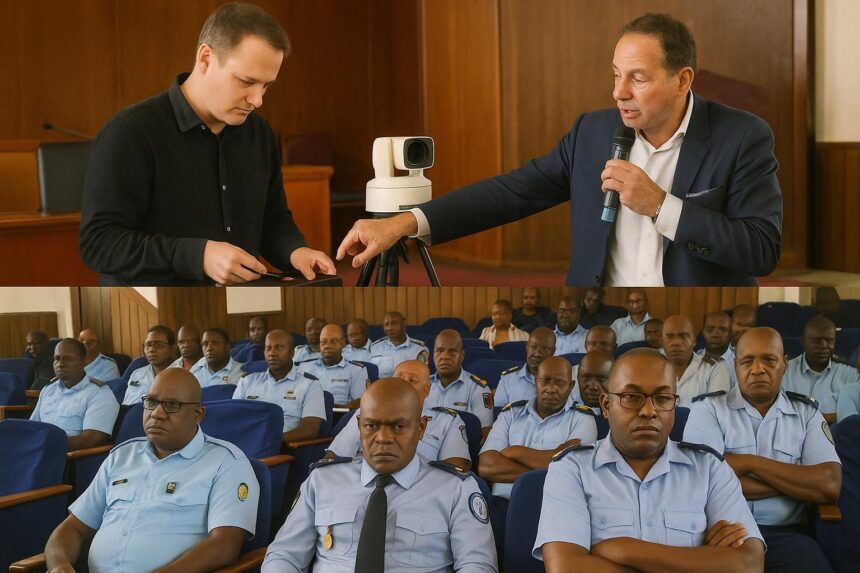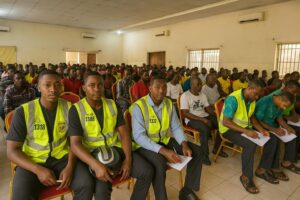Smart speed control arrives in Brazzaville
Morning traffic hummed outside Brazzaville’s Prefecture on 24 September 2025 as thirty uniformed police and gendarmes gathered for a course unlike any other: learning to operate the first two mobile speed radars officially acquired by the Directorate-General of Land Transport.
Director General Atali Mopaya opened the session in partnership with La Congolaise des Frets, underlining how technology can reinforce day-to-day patrol work and help Congo reach global safety goals without burdening motorists who already face rising fuel and maintenance costs.
Hands-on training with German tech
Lessons were led by Cédric Mazet, commercial director of Jenoptik, the German firm supplying the devices. He alternated between classroom slides, showing infrared imaging and data logging, and parking-lot drills where each officer took turns mounting the radar on a patrol motorcycle in under three minutes.
Participants practiced capturing licence plates from vehicles driving at different angles, a common situation on Boulevard Alfred Raoul. The radar’s tablet immediately displayed speed, plate number and GPS location, allowing instructors to discuss how evidence must be stored to stand in court.
Why speed control matters
Speaking to reporters, Atali Mopaya called the two radars a pilot phase that will be expanded in stages as funding permits. “We prefer gradual implementation to guarantee reliability and transparency,” he explained, noting that public confidence is essential for enforcement.
He also announced a parallel communication campaign featuring televised spots, school visits and social-media challenges encouraging drivers to share “I slow down” selfies. The objective is to make speed control feel cooperative rather than punitive, especially among young motorbike users.
Observers from the National Road Committee reminded the class that speed remains the leading contributing factor in nearly half of the collisions recorded last year across Brazzaville and its suburbs, according to police statistics shared during the workshop, adding urgency to the training agenda.
Field experience echoes statistics
Captain Jean-Bruno Sandé, head of Brazzaville’s Traffic Unit, welcomed the devices after years of witnessing carnage on the Alfred Raoul corridor, Talangaï viaduct and Kintélé bridge. “When a boulevard becomes a test track, tragedy follows,” he told the trainees.
His informal logs list dozens of crashes where excess speed turned simple fender-benders into fatalities. By allowing officers to intervene earlier, Sandé expects to reduce the response time between infraction and sanction, a gap that often fuels reckless driving.
Aligning with Congo’s 50 percent pledge
Congo reaffirmed during the Global Road Safety Assembly in Marrakech on 20 September 2025 its commitment to halve deadly accidents by 2030. The radar initiative is cited in the national roadmap as a “quick-win” capable of delivering measurable results before larger infrastructure upgrades.
Similar sessions are pencilled for Pointe-Noire and Dolisie early next year, once funds clear. Officials say sharing skills nationwide prevents enforcement from staying in the capital alone and keeps pace with rising freight traffic on main corridors.
From pilot phase to nationwide roll-out
According to La Congolaise des Frets deputy director Paul Eric Sahly, the partnership model keeps costs manageable. LCF handles customs and logistics, while the D.G.T.T focuses on training and calibration, an arrangement he describes as “lean governance that delivers tangible safety dividends”.
For now only two devices exist, so patrols will rotate them across hotspots revealed by past crash maps. An internal dashboard will log citations, injury severity and community feedback, guiding where the next radars should go.
Mazet’s team promised remote technical support from Jenoptik’s European hub, available 24 hours, reassuring officers that firmware updates and diagnostics can be pushed over the air. He likened the service to “having an engineer on the pillion seat”.
The final afternoon ended with a live checkpoint on Avenue de la Paix. In fifteen minutes the radar clocked eight vehicles over the limit. Instead of issuing fines, officers handed leaflets and gave five-minute talks, highlighting the project’s education-first approach.
What drivers can expect next
In coming weeks, billboards will line main arteries telling motorists “Your speed is noticed”. Mopaya says the aim is habit-building, not ambush, giving drivers time to adapt before sanctions become automatic.
He argues that safer roads translate into healthier citizens and lower insurance premiums, benefits that ripple through the economy. “Every crash avoided frees hospital beds and keeps breadwinners at work,” he said, thanking presidential authorities for “constant encouragement toward pragmatic safety innovations”.
Taxi driver Augustin Mabiala, watching the demo, nodded approval yet asked officials to synchronise radar deployment with pothole repairs, arguing that enforcement and infrastructure should “move in the same lane” for maximum impact.
By late 2026, evaluations will decide whether mobile radars become as common as breathalysers at checkpoints. For now, the flashing device mounted on a motorcycle is a visible sign that Congo’s pledge to cut road deaths is no longer a distant aspiration but a work in progress.






















